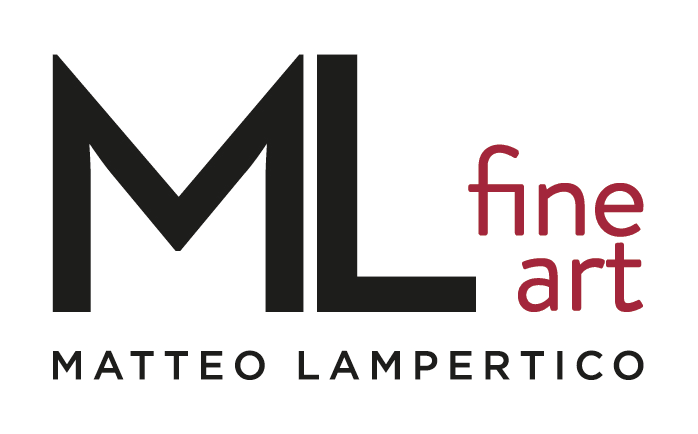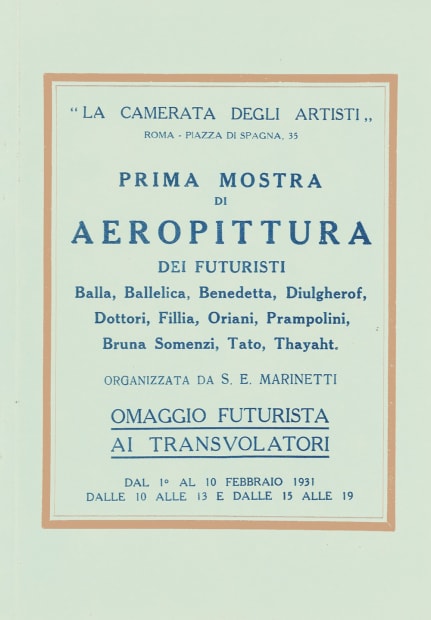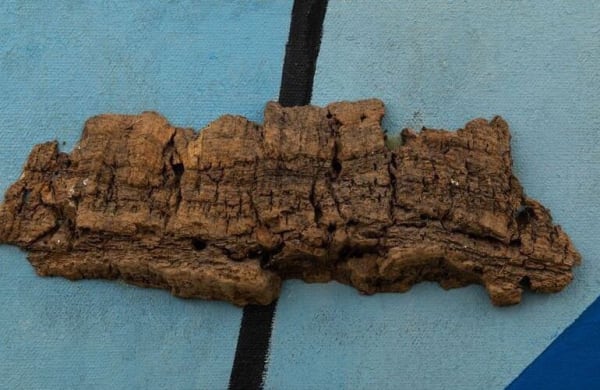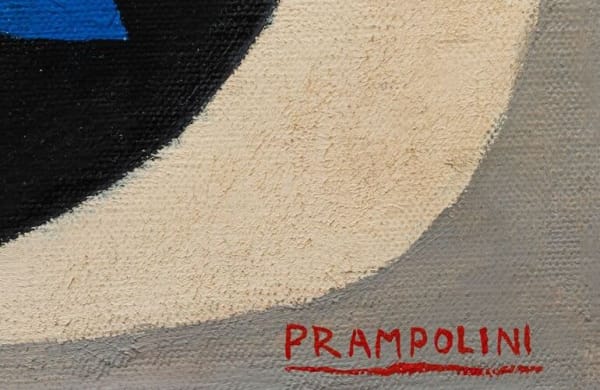Il concetto di "aeropittura" nasce nel 1929 ad opera di Marinetti, che il 22 settembre pubblica su "La Gazzetta del Popolo" di Torino il "Manifesto dell'aeropittura futurista" con Balla, Benedetta, Depero, Fillia, Prampolini, Somenzi e Tato come cofirmatari, ma già dalla metà degli anni Venti inizia a diffondersi tra alcuni pittori futuristi.
Il successo dell'Aeropittura fu tale che nel 1939, in occasione della III Quadriennale d'Arte Nazionale, fu allestita una mostra collettiva intitolata appunto "Mostra futurista di aeropittori e aeroscultori" e per l'occasione Marinetti scrisse un'introduzione in cui analizzava per la prima volta nel dettaglio questa tendenza, classificando il movimento in quattro declinazioni pittoriche e due aerosculturali. Gli artisti dell'aeropittura evolvono i concetti di velocità e dinamismo non solo attraverso treni, automobili o motociclette, ma anche attraverso visioni fisiche e mentali assolutamente innovative per il mondo dell'epoca.
Infatti, a partire dal 1929 il Manifesto fu ripubblicato più volte, ma i singoli firmatari e i successivi aderenti si divisero in due fronti proponendo due diverse concezioni dell'aeropittura. Da una parte Benedetta, Crali, Dottori, Somanzi e Tato che la interpretano come "paesaggio terrestre visto da un aereo in volo", dall'altra Prampolini e Fillia, seguiti dal gruppo torinese, che sostengono una nuova e più moderna concezione, con forti componenti surreali e chiare anticipazioni dello spazialismo del secondo dopoguerra. Verso la fine del 1930, le esperienze comuni di Prampolini e Fillia si definiscono nella proposta di superare le sensazioni meccaniche, prospettiche e visive di velocità e altezza percepite nell'esperienza del volo, per esprimere una sintesi cosmica e spaziale di nuove sensazioni riassumendo "in un unico organismo plastico" lo spirito delle diverse nature presenti nel cosmo "minerale, vegetale, umana e meccanica" (Fillia, Spintualità aerea, in "Oggi e Domani", 4 dicembre 1930). Un'espansione concettuale di ampio respiro, di natura psicologica e psichica, che in Prampolini si esprime con l'introduzione della materia bruta nelle composizioni dei suoi quadri di questo periodo. Granuli di catrame mescolati a frammenti litici o minerali, tappi di sughero che con la loro superficie ruvida sembrano meteoriti spente dialogano con le intersezioni dei piani atmosferici, con i pianeti e con le linee geometriche degli aerei che permettono l'apertura e la percezione di nuove dimensioni spirituali e mentali.
Per lanciare le nuove correnti aeropittoriche, Marinetti ideò nel 1931 una serie di tre mostre, tutte strettamente collegate tra loro in un breve lasso di tempo e tutte recanti il manifesto stampato in catalogo: la prima a Roma in febbraio, la seconda a Trieste in marzo e la terza a Gorizia all'inizio di giugno.
L'opera qui presente è un raro esempio di aeropittura di Prampolini, che è stata esposta a tutte e tre le mostre: a Roma, a Trieste e finalmente a Gorizia, dove è stata venduta e poi rimasta nella stessa collezione per novant'anni.
I cataloghi di Trieste e Gorizia non illustrano dipinti di Prampolini e l'identificazione si basa quindi principalmente sul titolo. Le quattro rimanenti Aeropitture di questa serie - estremamente importante in quanto la prima del nuovo tema - sono state successivamente esposte in Francia, alcune con titoli forse diversi. L'Aeropittura | è indicata da Filiberto Menna come esposta in una mostra del 1932 a Parigi (Enrico Prampolini et les aéropeintres futuristes italiens, Galerie de La Renaissance, Paris, 1932), ma nell'elenco delle opere esposte compare una sola Aéropeinture (n. 44 del catalogo, illustrata), che è invece pubblicata da Menna (cat. 81, fig. 163) con il titolo Velocità di elica, 1990 c. (ubicazione sconosciuta).
Da un punto di vista stilistico l'Aeropittura IV può essere collocata tra il 1929 e la fine del 1930. Da un lato, infatti, come residuo della prima iconografia aeropittorica, troviamo la sagoma dell'aereo che caratterizza anche il noto Itinerario plastico del 1829; dall'altro, contiene già quegli elementi polimaterici (sughero e granuli di catrame) che caratterizzano le opere dal 1931 in poi.
- Paolo Baldacci



 Luigi Colombo (Fillia)Figura nello spazio, 1930Signed lower rightOil on canvas125 x 105 cmML fine art
Luigi Colombo (Fillia)Figura nello spazio, 1930Signed lower rightOil on canvas125 x 105 cmML fine art





